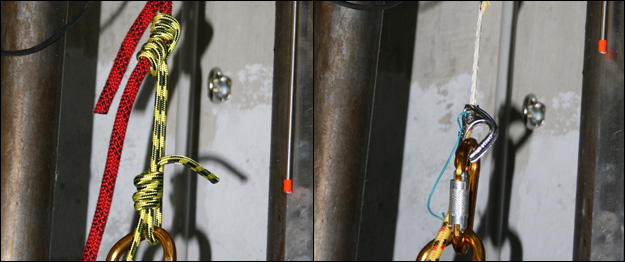
Swiftwater Rope Testing - Prussics & Petzl Tiblock
One of the things that we often get asked about on rescue courses is how strong Prussik loops are, and if mechanical ascenders (especially the Petzl Tiblock) would be better on wet ropes. So we decided to test various different set ups to answer these questions.
The first thing we looked at was the strength of prussic loops? The two most commonly used knots to make prussic loops are the overhand and the double fisherman's knot. Here the Double fisherman's knot was a clear winner producing prussic loops that were almost twice as strong as the overhand knot.
The second factor was the difference between the cord diameter and the main line diameter. Some people seem to think that it should be 2/3 of the main line while others say 2 mm less. So we looked at different diameters of prussic cord on different main lines to try and work this out.
As this is a test for swiftwater rescue situations we also tested in wet conditions, where we correctly assumed prussics would grip less than on dry ropes.
Finally we looked at how a Petzl Tiblock compares to a prussic as it is less prone to differences due to wetness or diameter and is quicker to place on a rope in an emergency.
Results
Prussic loops & Tiblock strength
| Prussic | Wet / Dry | Strongest Knot | Tested Strength in kN |
|---|---|---|---|
5mm Edelrid Powerloc Expert Loop |
Dry |
Double Fishermans |
11.03 |
6mm Edelrid Powerloc Expert Loop |
Dry |
Double Fishermans |
14.46 |
7mm Edelrid Powerloc Expert Loop |
Dry |
Double Fishermans |
21.12 |
8mm Edelrid Powerloc Expert Loop |
Dry |
Double Fishermans |
24.14 |
Tiblock |
Dry |
- |
12 * |
Edelrid 11mm RED Superstatic - Semi-static Rope *
| Prussic | Wet / Dry | Knot | Tested Strength | Comments |
|---|---|---|---|---|
7mm Edelrid Powerloc Expert |
Dry |
3-wrap |
16.37 |
Prussic + Sheath broke at same time |
8mm Edelrid Powerloc Expert |
Dry |
3-wrap |
15.43 |
Slip at 10, 12, 14 then sheath broke at 15.43 |
7mm Edelrid Powerloc Expert |
Wet |
3-wrap |
13.85 |
Slip at 12, then sheath broke at 13.85 |
8mm Edelrid Powerloc Expert |
Wet |
3-wrap |
11.60 |
Slip at 8, 10, then main line broke at 11.60 |
Tiblock + HMS Karabiner |
Dry |
- |
5.99 |
Sheath Broke |
°hf KM 10 Throwbag rope *
| Prussic | Wet / Dry | Knot | Tested Strength | Comments |
|---|---|---|---|---|
5mm Edelrid Powerloc Expert |
Dry |
3-wrap |
7.10 |
No Slip, main line broke |
6mm Edelrid Powerloc Expert |
Dry |
3-wrap |
6.20 |
Slipped on main line, both lines glazed |
5mm Edelrid Powerloc Expert |
Wet |
3-wrap |
5.72 |
Prussic loop Broke |
6mm Edelrid Powerloc Expert |
Wet |
3-wrap |
6.00 |
Slipped on main line, both lines glazed |
Tiblock + HMS Karabiner |
Dry |
- |
5.85 |
Sheath Broke |
°hf Syntec 7.5mm Throwbag rope *
| Prussic | Wet / Dry | Knot | Tested Strength | Comments |
|---|---|---|---|---|
5mm Edelrid Powerloc Expert |
Dry |
3-wrap |
4.60 |
Sheath Broke |
6mm Edelrid Powerloc Expert |
Dry |
3-wrap |
3.75 |
Slipped on main line, both lines glazed |
5mm Edelrid Powerloc Expert |
Wet |
3-wrap |
3.59 |
Slipped on main line, both lines glazed |
6mm Edelrid Powerloc Expert |
Wet |
3-wrap |
4.21 |
Slipped on main line, until sheath broke |
Tiblock + HMS Karabiner |
Dry |
- |
3.47 |
Sheath Broke |
Conclusions:
As we can see from the test results prussics can be very strong, but they can also be surprisingly weak. The prussic loop is very strong as a loop, but when the prussic knot is tied on the rope, it is the tight radius in the prussik knot where the loop will break. So the overall strength of the loop is not the most important point (the same is true of the overall strength of the Petzl Tiblock at 12 kN). Overall strength depends not only on the strength of the prussic loop but also on the strength of the sheath of Kernmantel main lines and the amount of friction between prussic, sheath & core.
The best diameter of a prussic loop does not seem to follow any kind of rule in our limited testing and there was sometimes a different winner in wet conditions than with dry ropes. So for swiftwater rescue we would recommend the following:
- 11mm Edelrid Superstatic - 7mm Edelrid Powerloc Expert - 4mm difference or 2/3 or 5/8 main line ∅
- 10mm °hf Throwbag KM - Alpine - 6mm Edelrid Powerloc Expert - 4mm difference or 5/8 main line ∅
- 8mm °hf Throwbag Syntec - 6mm Edelrid Powerloc Expert - 2mm difference or 3/4 main line ∅
The Petzl Tiblock cut through the sheath of every Kernmantel rope tested, at a lower load than the prussics did. For this reason we do not recommend the use of the Petzl Tiblock instead of prussics in swiftwater rescue situations. Perhaps the Tiblock would perform better on iced ropes against prussics.
For this testing we used 1 year old throwbag ropes from °hf and new prussic cord and 7 year old semi-static rope from Edelrid. These are some of the strongest kernmantel ropes on the market. If you are using ropes of a lower quality then results could well be much lower! For brand new ropes the results could also be slightly higher.
These tests were performed in cooperation with Axel Manz. Many thanks to Bonack for allowing us the use of their excellent testing facilities.